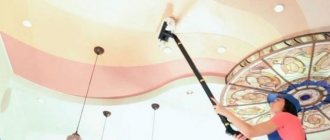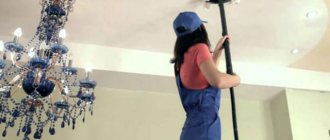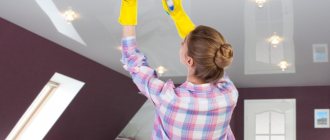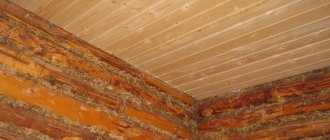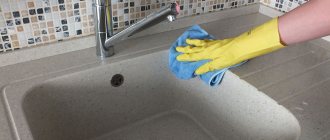Glossy ceilings are firmly integrated into the interior of modern houses and apartments. Previously, they were a sign of glamor, luxury and excessive pathos. Today it is considered good taste.
Stretch ceilings with a glossy effect are a great opportunity to visually expand a room, give it light and freshness. As a rule, such a decorative highlight is installed in the bathroom or kitchen. However, this does not mean that the ceiling will look bad in the hall or nursery - it is universal.
In addition to the original appearance, the surface has another undeniable advantage. Unlike conventional painted ceilings, it is easy to maintain. This coating is very easy to clean from dirt, grease, soot and other unpleasant stains. Read our article about how to properly wash a glossy stretch ceiling, what products to use, the intricacies and secrets of absolute cleanliness.
How you can and cannot wash a glossy stretch ceiling (purchased and folk remedies)
Finding cleaning chemicals to remove dirt from a glossy canvas is not difficult. For this task, you can use either expensive store-bought sprays, a homemade solution, or even warm tap water. The choice of product and sponge or rag will depend on the type of stain.
Important: you should absolutely not use baking soda, acetone or powder to wash the ceiling, as it may become dull, scratched or cracked.
It is also not recommended to use a vacuum cleaner to remove cobwebs or dust. For these purposes, it is better to take a mop with a soft foam sponge at the end.
Among the folk remedies that are easy to make at home, you can use a solution of grated laundry soap and warm water in the proportion: 1/2 piece per 2.5 liters. Dishwashing liquid without dyes is also suitable.
You can also wash a glossy stretch ceiling with store-bought products sold in departments with household chemicals. As a rule, in the living room there is no need for thorough cleaning of the ceiling; there it is enough to use a damp cloth and a light soap solution. The housewife will require special attention to the ceilings in the kitchen or bathroom. The main enemies of these rooms are grease and plaque. Window cleaners will help eliminate unpleasant defects at home.
Features of caring for ceilings in the kitchen and bathroom
During the operation of these premises, a special microclimate is formed. Due to increased humidity, condensation appears. And in the kitchen, while cooking, small splashes of fat fall on the ceiling and freeze. Problems like these make cleaning more difficult.
In the bathroom, especially with poor ventilation, many traces of drops and drips form. They can be easily removed using glass cleaning sprays. You can add a couple of tablespoons of ammonia to your regular detergent.
In the kitchen, maintenance of suspended ceilings is carried out more often, as the finish gets dirty faster. Dishwashing detergent can remove greasy stains. Old marks can be treated with a steam generator. Impurities soften and come off easier. The device is set to a low temperature (not higher than 40-45°C) and kept at a short distance from the canvas.
Advice! The most practical kitchen coating is glossy film. In a matte or satin texture, fat is partially absorbed, which complicates care. The fabric also has a non-uniform surface and is also less resistant to wet cleaning.
What tools can you use?
The cleanliness and proper appearance of a glossy stretch ceiling depend on how to properly wash the surface. This should be done with rags or sponges made of soft fabrics. Napkins are also suitable for these purposes. Do not use hard brushes, sponges with a rough surface or shedding rags.
Don't rub too hard. If you follow the recommendations, removing the stain will not be difficult. It will be enough to soak the dirt and remove the dirt using circular movements.
Tip: before you start cleaning, remove all jewelry from your hands: rings and bracelets. They can accidentally scratch a delicate surface. It is best to handle suspended ceilings while wearing rubber gloves.
General recommendations from experts
To avoid damaging the fragile fabric, precautions must be taken. Before starting cleaning, remove rings and other decorations that can pierce the film.
Only soft products that do not contain abrasive particles or acetone are suitable. Use lint-free rags (microfiber or flannel) or a sponge (soft side only). Do not rub or press hard on the ceiling.
Before using a new product, be sure to test it in an inconspicuous area. Apply a small amount to the ceiling and wait 10-15 minutes. If there are no traces left on the surface, the composition can be used.
Proper and regular maintenance increases the life of suspended ceilings. It is important to choose a product that cleans well, but does not harm the surface.
How to wash light stains
Light stains on the surface can be wiped off with plain water. For this you will need a basin. The temperature of the liquid should be slightly warm. Wet a rag or sponge thoroughly and wipe away the dirt, thereby moistening it. Next time, squeeze the rag harder. Use circular movements to clean the area of contamination until it is completely clean. Then wipe dry with a terry towel.
If the stains have not disappeared, you can use a solution of laundry soap or detergent. For effectiveness, it is recommended to apply foam rather than liquid. Soak the stains with it. Also, use gentle circular movements to treat the surface. Wipe dry.
Cleaning a fabric seamless ceiling
When caring for such ceilings, it is necessary to treat them more carefully than those made from PVC films. Do not rub the same place for a long time, do not press on the canvas when touching. Hand movements should not be circular, but back and forth. If there are very strong stains, then you can use a powder solution (when you take a small amount of washing powder and mix it with water until the powder granules are completely dissolved). Or apply foam - a car interior cleaner - to the stain for 3-5 minutes, then wipe with a clean white cloth - the stain should disappear.
How to clean heavy stains
Greasy marks or deposits cannot be removed simply with water or soapy water. But we will tell you how to wash a glossy stretch ceiling if the dirt is difficult to remove. We need “heavy artillery” here. Therefore, it is necessary to use alcohol-containing products that will corrode the layer of fat or plaque. Universal sprays for cleaning glass or mirrors are perfect. They spare the delicate surface and give it shine and crystal purity. A soft fiber cloth or porous sponge will help to wash without streaks.
Tip: Don't use newspaper for cleaning. It will scratch the surface and leave marks.
Operating rules
Important! According to the type of raw material, products are divided into: film (PVC) and fabric.
If you clean correctly and according to the instructions, you can maintain the original appearance of the canvas for many years. In order not to spoil your purchase right away, you should protect it from the influence of such factors:
- Impact of a mechanical nature. In terms of strength characteristics, fabric material differs from film material by higher rates. But both of these types should not be cleaned with hard brushes, abrasives or rough cloths. To avoid deformation or damage, do not press on the panel.
- Temperature changes. At low temperatures, the coating may crack, and at very high temperatures, it may deform or stretch.
- Exposure to chemistry. The use of alkali, acid or compositions containing acetone when cleaning can cause stains, wash away the design, and in the worst case, even cause holes.
- It will be much easier for you to protect the panel from the influence of negative factors if its initial placement corresponds to the purpose of the room. For example, choose fabric options for cold rooms or terraces, and PVC for the kitchen.
Important! Please be aware that using the wrong cleaning solution may cause the design to be removed or smeared, colors to change, wrinkling or strange stains to appear. Give preference to specialized liquid products from a trusted manufacturer. Pay close attention to the composition; it should not contain acetone or abrasives. Test the product on a small, inconspicuous area before extensive use.
How to care for a glossy ceiling
To avoid having to rack your brains on how to remove stubborn stains, you need to periodically use gentle types of cleaning using the correct methods. Caring for a glossy stretch ceiling begins with removing dust with a flannel cloth. After the detergent foam is applied, a thin layer is applied. Wipe dry with light, non-pressure movements.
It is very important to be careful and not overdo it, otherwise the surface will be damaged. The structure of the gloss is created in such a way that any dirt can be removed without effort, which is why the design is especially popular. She is valued for her unpretentiousness.
Tips for proper use of suspended ceilings
Manufacturers of suspended ceilings claim that the service life of modern products is almost unlimited. Most likely, this is true, because the coatings are made from durable and wear-resistant materials that can withstand any impact and load perfectly. And the general rules for caring for ceilings are not that complicated.
And yet, the service life of the ceiling largely depends on its operating conditions. There are a number of factors that negatively affect the characteristics of products:
- a suspended ceiling can become deformed when exposed to too low or high temperatures. Limitations depend on the material from which the ceiling covering is made. Thus, PVC ceilings are more suitable for rooms with a temperature range of 10-50°C. If the loggia is being finished, then it is better to install a fabric ceiling here. Its structure and appearance will remain unchanged even in severe frosts down to -40°C.
- If the room is being renovated, the suspended ceiling must be covered with plastic film. This will protect the coating from dirt and mechanical damage.
- It is better to remove stains that appear immediately, without waiting for the contamination to penetrate deep into the structure of the material.
By following the manufacturer's recommendations and regularly maintaining your ceilings, you can maintain the original attractiveness of the stretch fabric for a long time.
How to wash a suspended ceiling in a garage or at home.
Content
How to wash without streaks
Experience shows that soap often leaves unsightly marks. Surfaces with colorful patterns are not susceptible to stains. If the glossy canvas is plain white or black, then you need to make sure that no unwanted marks remain after your cleaning.
Alcohol-containing products do an excellent job of this task. The main thing is to never clean with a damp cloth. Use only dry cloth or foam.
Tip: to avoid streaks, wipe the ceiling not in a circular motion, but from left to right or parallel to the ceiling seam.
Extreme ways
It happens that during repairs paint splashes fall on the ceiling. They need to be wiped off immediately. Dried paint must be removed with a solvent, but so that it only gets on the paint and not on the ceiling. It is extremely difficult to do this accurately. Try applying the solvent to a cotton swab and spot-treating the stains.
Some types of fabric ceilings can be washed using foam for cleaning car dealerships, as well as a solution of 5% soda ash. Just don't use dry soda. It needs to be completely dissolved in warm water, and if the stain is very complex and cannot be removed by anything else, add a little salt or greasy clay to the solution. The composition is applied to the stain using a sponge and left until completely dry. Then remove with a damp sponge. Baking soda helps get rid of fungus on the ceiling and the smell of mold.
But remember that soda, in general, is prohibited from using for washing suspended ceilings (especially PVC).
Let's summarize the recommendations for washing and cleaning ceilings in two tables:
| Type of stretch ceiling | What to wash with |
| Glossy | Ammonia solution, glass cleaners, Edelweiss, Nouvel, LOC from Amway, shampoo, liquid soap. |
| Matte | Washing powder, soap solution, shampoo, liquid soap, Altezza, Nouvel. |
| Fabric | Dry cleaning (vacuum cleaner, dry soft lint-free rags and napkins), for severe contamination - soap solution, liquid soap, ammonia with water, “CeruttiST”, “Sofitto”, improvised means without chlorine. |
And now a table with a list of means for removing various types of contaminants:
| Type of pollution | What to wash with | |
| PVC | Fabric | |
| Yellowness, nicotine coating, nicotine smell | Soap solution with the addition of essential oils and fragrances. A solution of ammonia. | Car interior cleaner |
| Ketchup, tomatoes | Dishwashing detergent, generous application of hydrogen peroxide. Then wipe with a dry cloth | Ceiling replacement/painting |
| Dirt with traces of grease | Ammonia solution (ammonia solution), soap foam | Soap solution locally |
| Stains from utility leaks, rust | Soap solution or dishwashing detergent + ammonia in a ratio of 1:1 | Ceiling replacement/painting |
| Mold, fungus | The canvas is removed and the ceiling is treated. To do this, use special anti-mold and mildew agents, bleach, antiseptics, potassium permanganate with quicklime, copper sulfate, and undiluted vinegar. If there is mold on the material, its base is also washed from the inside. Just not with aggressive, but gentle means: a solution of dishwashing detergent, baby powder, hydrogen peroxide, a solution of vinegar. An effective but expensive remedy is grapefruit seed extract, tea tree oil (10 drops per glass of water). Before re-installing the stretch ceiling, all surfaces must be thoroughly dried for at least two days. | |
| Fat | Soap solution and ammonia solution | Ammonia solution |
| Dust, cobwebs, surface deposits | Soap solution | Dry cleaning |
| Insect tracks | Any gentle product (soap solution, dishwashing detergent, etc.) | Dry cleaning |
| Old dirt | Aqueous solution of ammonia, vodka / alcohol + water | Vodka / alcohol + water, ammonia solution |
| Limescale | "Care Noir", a mixture of vinegar and soda (dissolved in water). | — |
| Soot, soot | Applying a soap solution for a long time (20 minutes). Then rinse and reapply. A solution of ammonia. | Ammonia solution |
| Food contamination | Ammonia solution | Ammonia solution |
| Spray | Soap solution and ammonia solution | Dry cleaning |
| Loss of shine, stains | Ammonia solution (only for glossy ceilings). Vodka with water | Stains are removed using special products for fabric ceilings. |
| Unpleasant odors | A weak vinegar solution, a soap solution with fragrances. | The same means. |
| Minor dirt | Eraser, dry/slightly damp lint-free cloth, damp cloth | Dry cleaning, slightly damp cloth, soft brush |
| Traces of construction glue, liquid nails, resin, putty, tape, other construction dirt | Gel-type dishwashing detergents, glass cleaner, hydrogen peroxide, warm soapy water, spot removal of stains using white spirit, solvent (but so that the product does not get on the canvas). Softened putty and paint can be removed with a soft rubber spatula. Dried liquid nails cannot be removed. | You can try the same remedies, but only if the stains are fresh. Otherwise, you will have to paint or replace the ceiling. |
| Stains of oil, water-based, acrylic paint | Oil paint: spot removal with solvent on a cotton swab. Then a soap solution and removing the residue with a dry cloth. Water-based emulsion: warm water, a solution of soft washing powder. Acrylic paint: special gel for removing acrylic paint, dishwashing detergent, hydrogen peroxide. Just don't use circular movements! Paint is removed using back and forth movements. | |
| Marker, felt-tip pen | Soap/weak alcohol solution | |
What not to do
To summarize, we can say that washing a suspended ceiling at home is not at all difficult if you follow basic precautions, namely:
- Do not use abrasive solutions, especially those containing acetone - it can damage the material, ruining its appearance. It is best to test the product on a small, poorly visible area before work;
— Under no circumstances should the use of hard brushes be allowed, even on very old stains - they must be soaked and then washed using soft, gentle products;
— If you prefer to clean with a mop, be extremely careful with sudden movements to avoid deformation of the canvas;
— All existing seams on the ceiling surface should be processed not in a circular motion or crosswise, but exclusively lengthwise, in order to avoid the accumulation of dirt at the joints.
Be sure to take into account the properties of different fabrics, choose the right accessories and cleaning products. You should also monitor the possible appearance of stains in certain places. Sometimes the cause may be carbon deposits or leaking pipes from the upper floors. The first thing to do is eliminate the potential threat.
Stretch ceilings are an excellent modern finishing material that can give even the most ordinary interior its own zest, and proper use and care will help preserve all the charm of the design for many years.
How to make your own hand wash (for grease stains)
There are many useful video instructions published on the Internet on how to make a stretch ceiling cleaner at home. The most popular and proven of them is a solution based on ordinary table vinegar. You will need 100 ml of it for 1 liter of water at room temperature. However, this method has one not very pleasant factor - a pungent odor. Afterwards it will take several hours to ventilate the room.
Vodka or alcohol is used in the same proportion, which can be found in almost every home. They quickly remove dirt and do not leave unwanted streaks.
You now know how to wash a glossy stretch ceiling and with what means. It does not require a lot of effort and expense when cleaning. However, regular light care will be useful and will extend its “life”. Wet and dry quick cleaning will allow such mirror beauty to delight its owners for a long time and create home comfort.
Tips from professionals: what to do if the ceiling has lost its color and shine?
- The washing powder solution can be used to wash the gloss after it has completely dissolved. The foam is washed off with clean water, and the fabric is wiped with a soft rag. There should be no streaks after cleaning.
- When vacuuming, if there is no nozzle without bristles, you can use a microfiber cloth attached to the brush. Cleaning is performed at low power.
- PVC fabric is afraid of low temperatures, it becomes fragile. In a room with a suspended ceiling, sudden temperature changes should not be allowed, so long-term ventilation is prohibited.
- Before starting work, make sure that the napkin does not leave fibers on the canvas and does not stain the surface.
- The installation of lighting and heating equipment should be carried out according to calculation; too many lamps or registers can lead to overheating and melting of the canvas.
- Where tension fabrics are installed, it is not recommended to open bottles of champagne or other sparkling wine - an accidentally ejected cork can permanently damage the ceiling.
- A suspended ceiling can save furniture and wall decoration from flooding by neighbors from the floor above. PVC films and fabrics can withstand up to 100 l/m2 of water, sagging under this weight without breaking. To pump out the liquid, you will have to call a special service, since you won’t be able to do it yourself.
- To restore shine to a panel that has lost its shine, it is enough to use a piece of suede.
Dirt that can't be cleaned
There are several types of contaminants that cannot be cleaned by any methods or means:
- stains and marks from ink, markers, paints that have penetrated into the structure of the film;
- damage from sparks from sparklers, matches;
- resinous components of tobacco smoke penetrating into the fibers of the material;
- discolored spots as a result of exposure to aggressive environments;
- traces of chewing gum, tape, plasticine.
If there are such stains, you will have to call the craftsmen and completely redo the ceiling.
SMD and DIP: what's the difference?
Before we tell you what the difference is between these technologies, we need to mention one characteristic of LED modules. This is the layout density, or pixel pitch. For the street, P16 or P20 are usually used. The most popular, middle option, which is suitable for both screens and tickers, is P10. The highest quality LED screens are P4, P3 and P2.5. The smaller the distance between the pixels, the higher the image resolution.
The layout should be chosen based on how close the person will be to your equipment. For example, for P4 to look as good as a TV, you must stand at least 3-5 meters away. To find out which component characteristics are suitable for your design, call 8 800 700-87-60. Our managers will help you make a choice!
Causes and types of pollution
Although the surface above your head is not exposed to the same intense impact as floors or walls, it is influenced by many factors.
The surface of suspended ceilings may lose its attractiveness for the following reasons:
- Dust. The smallest particles of the substance, settling on the ceiling, gradually turn into a solid and gray substance, which significantly spoils its appearance.
- Leaking roof or neighbors' plumbing. Water passing through a reinforced concrete slab acquires a specific yellowish tint, which leaves marks on the lining.
- Oily coating. This is most common in areas such as kitchens, dining rooms and adjacent hallways.
- Smoke from cigarettes. Nicotine tar can seriously damage any surface. It is especially difficult to get rid of them.
- Traces of flies. These annoying insects can “sit” on the ceiling so much that over time it turns gray.
- Condensate. Due to temperature changes, fogging and droplets appear on surfaces. When they dry, they leave whitish marks.
In addition, the object may become dirty during repair work: be splashed with dirty water or mortar.
If the contamination is not eliminated immediately, it will become increasingly difficult to do so over time.
Prohibited care products
This list includes caustic, aggressive components and mixtures with them: powders with bleaches, abrasives of any fraction, caustic acids, alkalis. Also, do not clean PVC sheets with hard brushes or tools with short bristles, or abrasive coatings on dishwashing sponges. As for bleach powders, they can be used, but only on white fabrics and in the correct concentration of the composition.
Glossy or matte - which is better?
Since it has become obvious that a suspended ceiling is a good solution for the kitchen, it’s worth deciding which one. We must start from its surface. It comes in matte and glossy. And, as usual, each has its pros and cons.
Mat
The most popular, common and cheapest option. This is a smooth canvas of uniform color with slight roughness. The peculiarity of this material is that it always looks the same: both during the day with natural color and in the evening with artificial lighting - there are no glares or play of colors.
In the photo and even in life, it is impossible to determine with 100% certainty what is overhead: a matte white stretch ceiling or a perfectly smooth plastered and whitewashed coating. Due to this, it is the white mat that is used in classic-style kitchens, for which nothing else will suit.
This ceiling serves as a backdrop for bold and bright design solutions in the kitchen itself, because it does not attract attention to itself. But if you want to make some kind of image on the ceiling, you should prefer a matte material - this way the picture will be clearer and will not glare, reflect or be reflected on the walls
In this case, it is important, on the contrary, not to overload the set, but to leave the image on the ceiling as the highlight of the kitchen. But it is worth considering that raisins can become boring and boring, and changing the ceiling is expensive
Gloss
This option is more expensive, but it also has a much larger selection of colors. A glossy ceiling is suitable for a small kitchen in which you need to visually expand the space. The ceiling, creating the effect of a mirror, copes with this perfectly - the ceilings seem higher.
In this case, it is important to use white or light materials, since a black, dark or bright ceiling will not only not increase the space, but will also put pressure on you. A glossy ceiling combines beautifully with glossy ceramic floor tiles, but don’t try to match them
Typically, the glossy top is made either white or a couple of shades lighter than the walls. Looks great in kitchens in modern styles, for example, minimalism or hi-tech
A glossy ceiling combines beautifully with glossy ceramic floor tiles, but don’t try to match them. Typically, the glossy top is made either white or a couple of shades lighter than the walls. Looks great in kitchens in modern styles, for example, minimalism or hi-tech.
Glossy stretch ceiling in the interior (photo)
Watch this video on YouTube
Glossy ceilings have one drawback. The fact is that the material is produced in a certain width. Let's say 3 meters (different brands have different widths). If both walls in the kitchen are more than 3 meters, then two pieces of canvas will have to be joined by melting.
This creates a seam. And if it is practically invisible on a matte ceiling, then this will not work with a glossy ceiling, since the seam does not reflect light and immediately catches the eye. You should think about where the seam will be less noticeable and place it there.
But not all experts recommend using this coating for the kitchen. There are two reasons for this:
- traces from rising steam, stains from a rag will be noticeable on the glossy surface;
- the material may not withstand high or low (if the room is not heated) temperatures.
Therefore, if you have a strong desire to use a glossy ceiling in the kitchen, you should choose the material only from well-known manufacturers who can guarantee quality.
Combination
If you want to add uniqueness or separate the work area from the dining area, you can combine different types of material. For example, the cooking area should have a white matte “top”, and the dining area should have glossy facades to match. There are no limits to imagination here; they exist only at the expense of the wallet.
It is worth considering that a multi-level ceiling has long gone out of fashion and looks out of place in small kitchens, typical of Khrushchev-era buildings. The levels take up precious space and also put stress on the top, making it heavy and oppressive.
Which product to choose and how often to clean
Vinyl ceilings respond well to all products intended for the care of products made of polyvinyl chloride, in particular the popular “Mr. Muscle” for plastic windows. It cleans the film perfectly without leaving streaks on it, which makes it much easier to care for and there is no need to re-polish the surface. But you still have to wipe the film dry, otherwise wet marks containing even a small amount of detergent can leave streaks that, when dry, will change the color of the ceiling.
If we clean the ceiling once every six months, then small obvious stains should not be ignored. For example, on New Year's Day you unsuccessfully opened champagne, and an ugly yellow spot appeared on the ceiling. In this case, you can’t wait long - a fresh stain is easier to clean than one that’s six months old, and it’s better not to be lazy and immediately blot the dirt with a napkin.
Nowadays people are very busy and many often do not have enough time, not only to clean the room, but also to simply take care of themselves. Therefore, in order not to bother yourself with everyday problems and minor chores of cleaning the ceiling, you can invite specialists from a cleaning company, whose reviews are the most favorable. They know exactly how to clean your ceilings without harming them, and at this time you can devote time to your children.
